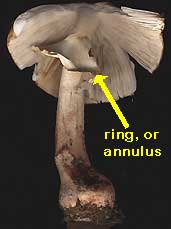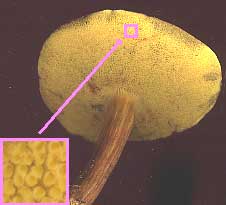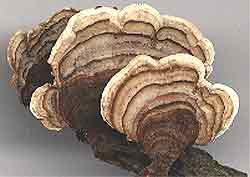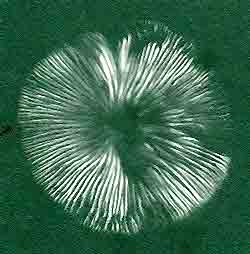 Mushrooms are
simply the spore-producing reproductive structures of certain kinds of fungi. The
four items at the right are mushrooms. Each mushroom has a large cap at
the top of a stalk. The mushrooms at the far right and far left in the
picture drop their spores from tiny holes, or pores on the caps' lower
surfaces. The big blue mushroom and the tiny orange one drop their spores from gills
on the caps' lower surfaces. I picked these mushrooms within five minutes of my door so
they are typical of what one might find. From the left in the picture, the first mushroom
is a Boletus. I think the small orange one is Hygrophorus miniatus.
The large blue one is Lactarius indigo, which is edible and which exudes copious
deep indigo-colored latex when injured, and the blackish one on the far right is Strobilomyces
floccopus, sometimes called "Old Man of the Woods," and it's also edible I
hope you're noticing that mushrooms are gorgeous, and their edibility opens up all kinds
of possibilities...! Mushrooms are
simply the spore-producing reproductive structures of certain kinds of fungi. The
four items at the right are mushrooms. Each mushroom has a large cap at
the top of a stalk. The mushrooms at the far right and far left in the
picture drop their spores from tiny holes, or pores on the caps' lower
surfaces. The big blue mushroom and the tiny orange one drop their spores from gills
on the caps' lower surfaces. I picked these mushrooms within five minutes of my door so
they are typical of what one might find. From the left in the picture, the first mushroom
is a Boletus. I think the small orange one is Hygrophorus miniatus.
The large blue one is Lactarius indigo, which is edible and which exudes copious
deep indigo-colored latex when injured, and the blackish one on the far right is Strobilomyces
floccopus, sometimes called "Old Man of the Woods," and it's also edible I
hope you're noticing that mushrooms are gorgeous, and their edibility opens up all kinds
of possibilities...!Again, mushrooms are just reproductive structures. Microscopic spores fall from the pores and gills of mushrooms such as those above and if environmental conditions are just right new fungal hyphae (HI-fee, the plural of "hypha") emerge from the spore, and these hypahe form a webby mass of typically white, interwoven, threadlike filaments known collectively as mycelium. Each individual, threadlike filament of the mycelium is known as a hypha (HI-fah), plural hyphae (HI-fee). This mycelium does the day-to-day work of breaking down and acquiring the fungus's food from humus in the soil, or decaying wood or some other substance, though usually isn't noticed by most people. At a certain time the mycelium mass forms a budlike structure someplace and from this emerges the mushroom.
What's the difference between mushrooms and toadstools? Essentially they're the same thing, except that usually toadstools are thought of as poisonous mushrooms. The word "toadstool" is used only in a very informal and vague sense, so we'll not use it again. Now, mushrooms have two especially attractive features making them fun to know:
Now, since mushrooms are such fun to know, today every good bookstore and library holds several mushroom books filled with gorgeous color plates. Nonetheless, sometimes it's hard, even impossible, to come up with a mushroom identification in which you have confidence. That's unfortunate, since getting the identification right is absolutely necessary if you plan to eat wild mushrooms! The problem is that there are just so many mushroom species that no easy-to-use field guide can cover them all. The problem is compounded by the fact that mushroom spores can travel for hundreds of miles on wind currents, so any truly comprehensive mushroom field guide would have to include species from most of the continent. When I find a new mushroom, my picture-filled field guide called Mushrooms of North America, by Orson Miller, Jr., despite its impressive name, provides an identification in which I have confidence less than half the time. In mushroom identification there's one particularly interesting technique worth giving special mention to. It relates to the fact that different mushroom species produce different-colored spores! Some species produce white ones, others black, brown, rusty, smoky-gray, salmon, pink, or even yellowish or green spores! Spore color is invaluable in mushroom identification.
In many habitats, mushrooms can appear at any time, especially when it's warm and wet. Overnight they can pop up in grassy lawns. Sometimes they form large circles or partial circles known as "fairy rings." If your lawn was recently a forest, mushrooms from fungi that earlier inhabited the forest's leaf litter and root zone can emerge, relics of a bygone ecosystem. Scan the trunks of large trees. Just keep your eyes open. Mushrooms are everywhere... You may be interested in these books focusing mainly on mushroom identification and biology, at Amazon.com: |
 The mushroom at the left obviously has something on its
stem, the ring, also known as the annulus, which the mushroom in the picture
above doesn't have. Sometimes mushroom arise from cuplike affairs known as cups,
or volvas, which neither of these have.
The mushroom at the left obviously has something on its
stem, the ring, also known as the annulus, which the mushroom in the picture
above doesn't have. Sometimes mushroom arise from cuplike affairs known as cups,
or volvas, which neither of these have.  Many mushrooms, such as the Boletus
shown at the right, instead of having gills radiating from the central stalk, have
roundish pores, Sometimes the stalk, instead of arising at the center of the cap, as do
both of these, attaches to the side of the cap. And one of the most agreeable things about
mushrooms is that they come in a rainbow of distinct colors. In other words, when
identifying mushrooms there are many, many unique and interesting features to use as field
marks. Any good mushroom fieldguide will present a brief survey of mushroom parts, with
drawings showing how the parts can vary, and what the various configurations and states
are called. Once you begin identifying mushrooms, you enter a whole new world...
Many mushrooms, such as the Boletus
shown at the right, instead of having gills radiating from the central stalk, have
roundish pores, Sometimes the stalk, instead of arising at the center of the cap, as do
both of these, attaches to the side of the cap. And one of the most agreeable things about
mushrooms is that they come in a rainbow of distinct colors. In other words, when
identifying mushrooms there are many, many unique and interesting features to use as field
marks. Any good mushroom fieldguide will present a brief survey of mushroom parts, with
drawings showing how the parts can vary, and what the various configurations and states
are called. Once you begin identifying mushrooms, you enter a whole new world... Not all fungus reproductive structures are thought of
as mushrooms. For example, you wouldn't call the two-inch-across structures illustrated at
the left mushrooms. They are indeed the spore-producing reproductive structures of a
fungus, called Turkey-tail Polypores (I wonder why?), but Turkey-tails generally
are not considered to be mushrooms. That's because to be thought of as a "real"
mushroom, a fungal reproductive structure must be "mushroom shaped" like the
mushroom at the top of the page, and more or less fleshy in texture. Also, Turkey-tails
are too tough and leathery to eat and that also disqualifies them from being mushrooms --
at least in my mind. Actually, the term mushroom is too nebulous and vague to debate and
has no technical basis.
Not all fungus reproductive structures are thought of
as mushrooms. For example, you wouldn't call the two-inch-across structures illustrated at
the left mushrooms. They are indeed the spore-producing reproductive structures of a
fungus, called Turkey-tail Polypores (I wonder why?), but Turkey-tails generally
are not considered to be mushrooms. That's because to be thought of as a "real"
mushroom, a fungal reproductive structure must be "mushroom shaped" like the
mushroom at the top of the page, and more or less fleshy in texture. Also, Turkey-tails
are too tough and leathery to eat and that also disqualifies them from being mushrooms --
at least in my mind. Actually, the term mushroom is too nebulous and vague to debate and
has no technical basis.  Unfortunately,
usually you can't just sit down next to a mushroom and immediately determine its spore
color. Usually you must remove the cap, take it home, and place it on a small sheet of
clear glass or paper. Ideally, the paper should have both black and white surface areas so
that if the spores are white they'll show up on the black part, if black, on the white.
After a few hours, if you're lucky, a beautiful spore print such as that at the
left will result. The lines coincide with the gills beneath the cap, from which the spores
have fallen. Notice the absence of spores in the very center, where the mushroom's stalk
was attached. The spore-print-making process slows down mushroom identification but, once
you've done it, it adds to your confidence in the identification... and you have a work of
art! By the way, the best mushrooms for making spore prints are those about three-quarters
grown. Sometimes the largest, most mature mushrooms in a group have already dropped their
spores, while the smaller mushrooms are too young to be producing them.
Unfortunately,
usually you can't just sit down next to a mushroom and immediately determine its spore
color. Usually you must remove the cap, take it home, and place it on a small sheet of
clear glass or paper. Ideally, the paper should have both black and white surface areas so
that if the spores are white they'll show up on the black part, if black, on the white.
After a few hours, if you're lucky, a beautiful spore print such as that at the
left will result. The lines coincide with the gills beneath the cap, from which the spores
have fallen. Notice the absence of spores in the very center, where the mushroom's stalk
was attached. The spore-print-making process slows down mushroom identification but, once
you've done it, it adds to your confidence in the identification... and you have a work of
art! By the way, the best mushrooms for making spore prints are those about three-quarters
grown. Sometimes the largest, most mature mushrooms in a group have already dropped their
spores, while the smaller mushrooms are too young to be producing them.